Related Research Articles
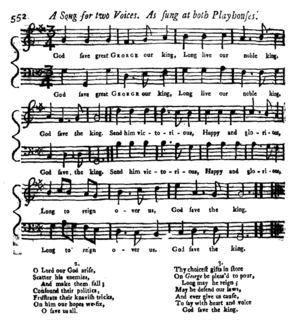
"God Save the King" or "God Save the Queen" is the national or royal anthem in most Commonwealth realms, their territories, and the British Crown Dependencies. The author of the tune is unknown and it may originate in plainchant, but an attribution to the composer John Bull is sometimes made.

A salute is usually a formal hand gesture or other action used to display respect in military situations. Salutes are primarily associated with the military and law enforcement, but many civilian organizations, such as Girl Guides, Boy Scouts and the Salvation Army use formal salutes. Ordinary civilians also salute informally to greet or acknowledge the presence of another person; such as a tip of the hat or a hand wave to a friend or neighbour.
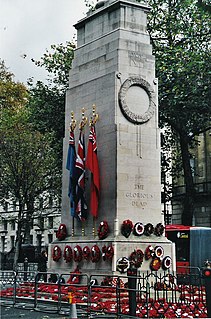
Remembrance Day is a memorial day observed in Commonwealth member states since the end of the First World War to honour armed forces members who have died in the line of duty. Following a tradition inaugurated by King George V in 1919, the day is also marked by war remembrances in many non-Commonwealth countries. In most countries, Remembrance Day is observed on 11 November to recall the end of First World War hostilities. Hostilities formally ended "at the 11th hour of the 11th day of the 11th month" of 1918, in accordance with the armistice signed by representatives of Germany and the Entente between 5:12 and 5:20 that morning. The First World War officially ended with the signing of the Treaty of Versailles on 28 June 1919.

"Kimigayo" is the national anthem of Japan. The lyrics of "Kimigayo" are likely the oldest among the world's national anthems, and with a length of 32 characters, they are also the world's shortest. The lyrics are from a waka poem written by an unnamed author in the Heian period (794–1185), and the current melody was chosen in 1880, replacing an unpopular melody composed by John William Fenton eleven years earlier. Its length of 11 measures is currently among the world's shortest. While the title "Kimigayo" is usually translated as "His Imperial Majesty's Reign", no official translation of the title or lyrics has been established in law.

"Sansoen Phra Barami" is the current royal anthem of Thailand. It was a de facto national anthem of Siam before 1932.
"Sri Lanka Matha" is the national anthem of Sri Lanka. "Sri Lanka Matha" was composed by Ananda Samarakoon and was originally titled "Namo Namo Matha".

A state visit is a formal visit by a head of state, or a head of government, to a foreign country, at the invitation of the head of state of that foreign country, with the latter also acting as the official host for the duration of the state visit. Speaking for the host, it is generally called a state reception. State visits are considered to be the highest expression of friendly bilateral relations between two sovereign states, and are in general characterised by an emphasis on official public ceremonies.
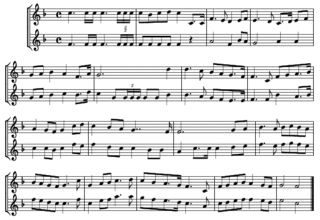
The National Anthem of the Islamic Republic of Iran is the national anthem of Iran. It was adopted in 1990, replacing the previous anthem used during the rule of Ruhollah Khomeini. It was composed by Hassan Riyahi, and the lyrics were written by Sayed Bagheri. It is the fourth official Iranian national anthem.
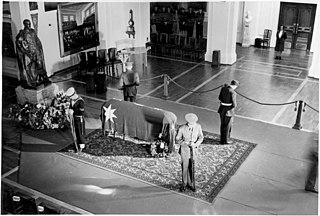
A state funeral is a public funeral ceremony, observing the strict rules of protocol, held to honour people of national significance. State funerals usually include much pomp and ceremony as well as religious overtones and distinctive elements of military tradition. Generally, state funerals are held in order to involve the general public in a national day of mourning after the family of the deceased gives consent. A state funeral will often generate mass publicity from both national and global media outlets.

The Act on National Flag and Anthem, abbreviated as 国旗国歌法, is a law that formally established Japan's national flag and anthem. Before its ratification on August 13, 1999, there was no official flag or anthem for Japan. The nisshōki (日章旗) flag, commonly referred to as the hinomaru (日の丸), had represented Japan unofficially since 1870; "Kimigayo" (君が代) had been used as Japan's de facto anthem since 1880.
Niue maintains diplomatic relations with various other countries and multilateral organizations.

"God Defend New Zealand" is one of two national anthems of New Zealand, the other being "God Save the King". Legally the two have equal status, but "God Defend New Zealand" is more commonly used. Originally written as a poem, it was set to music as part of a competition in 1876. Over the years its popularity increased, and it was eventually named the second national anthem in 1977. It has English and Māori lyrics, with slightly different meanings. Since the late 1990s, the usual practice when performed in public is to perform the first verse of the national anthem twice, first in Māori and then in English.

A loyal toast is a salute given to the sovereign monarch or head of state of the country in which a formal gathering is being given, or by expatriates of that country, whether or not the particular head of state is present. It is usually a matter of protocol at state and military occasions, and a display of patriotic sentiment at civilian events. The toast is usually initiated and recited by the host before being repeated by the assembled guests in unison; the composition varying between regions and types of gathering. There is sometimes a tradition of smashing a glass used for a loyal toast, so that no lesser toast can be made with it.
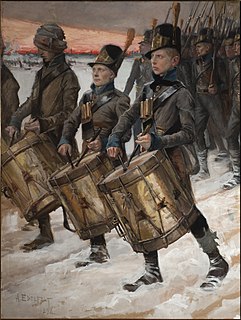
Björneborgarnas marsch is a Swedish military march from the 18th century. Today, it is mainly performed in Finland and has served as the honorary march of the Finnish Defence Forces since 1918.

"Negaraku" is the national anthem of Malaysia. It was adopted as the national anthem at the time of the Federation of Malaya's independence from the United Kingdom in 1957. The tune was originally used as the regional anthem of the state of Perak—"Allah Lanjutkan Usia Sultan",

Operation London Bridge was the funeral plan for Queen Elizabeth II. The plan included the announcement of her death, the period of official mourning, and the details of her state funeral. The plan was created as early as the 1960s and revised many times in the years before her death in 2022.
Ei ole üksi ükski maa is an Estonian patriotic song, which was created in 1987 by Alo Mattiisen. The lyrics were created by Jüri Leesment. The song was created in order to support movement against phoshorite mining in Virumaa.
References
- ↑ "National Anthem". Jamaica: King's House . Retrieved 2012-02-25.
- 1 2 3 4 "Act 390: National Anthem Act 1968; Incorporating all amendments up to 1 January 2006" (PDF). Malaysia: Commissioner of Law Revision. 2006. Archived from the original (PDF) on 11 January 2012. Retrieved 2 October 2011.
- 1 2 3 "DP 20-10, Ceremonieel & Protocol; Hoofdstuk 8 Muzikaal eerbetoon". Ministeriële & Defensie Publicaties (in Dutch). Netherlands: Ministry of Defence. §§2,5,10. Archived from the original on 25 April 2012. Retrieved 23 October 2011.
- ↑ "¿Sabías que "La Marcha de Ituzaingó" es un atributo presidencial como la banda y el bastón?". No. 3 December 2015. La Nación. 3 December 2015. Retrieved 19 December 2015.
- 1 2 3 "16.3 Australian national anthem". Protocol Guidelines. Department of Foreign Affairs and Trade (Australia). Archived from the original on 2009-10-08. Retrieved 2009-03-11.
- ↑ Law No 5700 of 1 September 1971 Cap.3 Sec.II Art.24.V
- 1 2 3 "Heritage Structure | Section 3 – Anthems, Salutes and Protocol". Government of Canada . Retrieved 2022-09-13.
- ↑ Eesti Rahvusringhääling (2021-02-16). "Eero Raun: "Piduliku marsi" autorit süüdistati esialgu plagiaadis". menu.err.ee (in Estonian). Retrieved 2022-04-23.
- ↑ Sõjaministeerium (1921), "Sõjaministri päevakäsud (1 Jan - 31 Dec 1921, nr. 1-753)", www.digar.ee, retrieved 2022-04-23
- ↑ Sõjaministeerium (1923), "Sõjaministri päevakäsud (3 Jan - 31 Dec 1923, nr. 4-584)", www.digar.ee, retrieved 2022-04-23
- ↑ Estonia selts (1910), "VII Laulupidu (12 Jun - 14 Jun) / Tallinna III Eesti laulupidu", sa.laulupidu.ee, retrieved 2022-04-23
- ↑ "Le Chant du Départ". Napoleon.org. Archived from the original on 2012-03-08. Retrieved 2012-02-09.
- ↑ Victor, A.J. "Haitian Patriotic Songs". ayitihistory.com. Retrieved 2009-03-11.
- ↑ "National Anthem". Department of the Taoiseach . Retrieved 2009-03-11.
- ↑ "P. W. Joyce: Ancient Irish Music » 47 - Mór Chluana". Na Píobairí Uilleann. Retrieved 3 February 2014.
- 1 2 "Joyce, Patrick Weston (1827–1914)". Ainm.ie (in Ga). Cló Iar-Chonnacht. Retrieved 3 February 2014.
- 1 2 3 Ó Cuív, Brian (2010-04-01). "Irish language and literature, 1845-1921". In W. E. Vaughan (ed.). Ireland Under the Union, 1870-1921. A New History of Ireland. Vol. VI. Oxford University Press. p. 425. ISBN 9780199583744 . Retrieved 3 February 2014.
- ↑ "Amhrán Dóchais". Library. Ireland: Contemporary Music Centre. Retrieved 3 February 2014.
- ↑ Casùla, Francesco Cesare (16 January 2013). Glossario di autonomia Sardo-Italiana: Presentazione del 2007 di FRANCESCO COSSIGA. ISBN 9788898062140.
- ↑ "Il primo inno nazionale, "S'hymnu sardu nationale"". 21 February 2021.
- ↑ Hoedeman, Jan; Theo Koelé (5 June 2004). "Beatrix: 'Het Wilhelmus is van mij'". De Volkskrant (in Dutch). Retrieved 23 October 2011.
- 1 2 3 "Protocol for using New Zealand's National Anthems". Ministry for Culture and Heritage (New Zealand) . Retrieved 2009-03-11.
- ↑ "Instructions for Playing the Anthem". Encyclopaedia of New Zealand . Ministry for Culture and Heritage (New Zealand). 1966.
If the first six bars only are used, as for a salute to the Governor-General as the Queen's representative, the anthem is to be played "fortissimo" at M.M. 60 crotchets.
- ↑ Webb, Michael (1993). Lokal Musik: Lingua Franca Song and Identity in Papua New Guinea. Cultural Studies Division, National Research Institute. p. 37. ISBN 978-9980-68-019-8.
- ↑ Quezon, Manuel L. (2004-06-24). "The Long view". Philippine Daily Inquirer . Archived from the original on 2020-02-26. Retrieved 2009-03-11.
- 1 2 Walsh, Thomas P. (2013). Tin Pan Alley and the Philippines: American Songs of War and Love, 1898-1946 : a Resource Guide. Rowman & Littlefield. pp. 271–273. ISBN 9780810886087 . Retrieved 6 January 2014.
- ↑ Music notation
- ↑ Guidelines for playing and singing national anthems Part IV of the Singapore Arms and Flag and National Anthem Rules
- ↑ Rutnin, Mattani Mojdara (1993). Dance, drama, and theatre in Thailand: the process of development and modernization. Tokyo: Centre for East Asian Cultural Studies for Unesco, the Toyo Bunko. p. 132. ISBN 978-4-89656-107-4 . Retrieved 7 March 2012.
- ↑ "หลักเกณฑ์การใช้เพลง "สดุดีจอมราชา"" (PDF) (in Thai). Office of the Prime Minister. 2018-07-23. Retrieved 2019-03-02.
- ↑ "ข้อบังคับทหารว่าด้วยการเคารพ" (PDF) (in Thai). Ministry of Defense of the Kingdom of THailand. 1936-03-12. Retrieved 2022-09-22.
- ↑ "A collection of Thai anthems" (in Thai). Thailand: Office of Public Relations. Archived from the original on 25 June 2006. Retrieved 7 March 2012.; "A collection of Thai anthems". Thailand: Office of Public Relations. Archived from the original on 24 June 2006. Retrieved 7 March 2012.
- ↑ TAWAT HUAHIN SUDDEE ข้างเขา หัวหิน (6 February 2012). "มหาฤกษ์ Combination RTA Band". Archived from the original on 2021-12-15. Retrieved 19 April 2018– via YouTube.
- 1 2 3 4 5 6 7 "Army Regulation 600–25: Salutes, Honors, and Courtesy" (PDF). U.S. Department of the Army. 2019-09-10. pp. 5–6, Table 2-1. Retrieved 2021-11-01.
{{cite web}}: CS1 maint: url-status (link) - ↑ "China Resumes Control of Hong Kong, Concluding 156 Years of British Rule". The New York Times. Retrieved 19 April 2018.
- ↑ Morris, Ewan (May 1998). "'God Save the King' Versus 'The Soldier's Song': The 1929 Trinity College National Anthem Dispute and the Politics of the Irish Free State". Irish Historical Studies. 31 (121): 72–90. doi:10.1017/S0021121400013705. JSTOR 30007063.
- ↑ Bogdanor, Vernon (1997). The Monarchy and the Constitution. Oxford University Press. p. 282. ISBN 9780198293347 . Retrieved 7 January 2014.